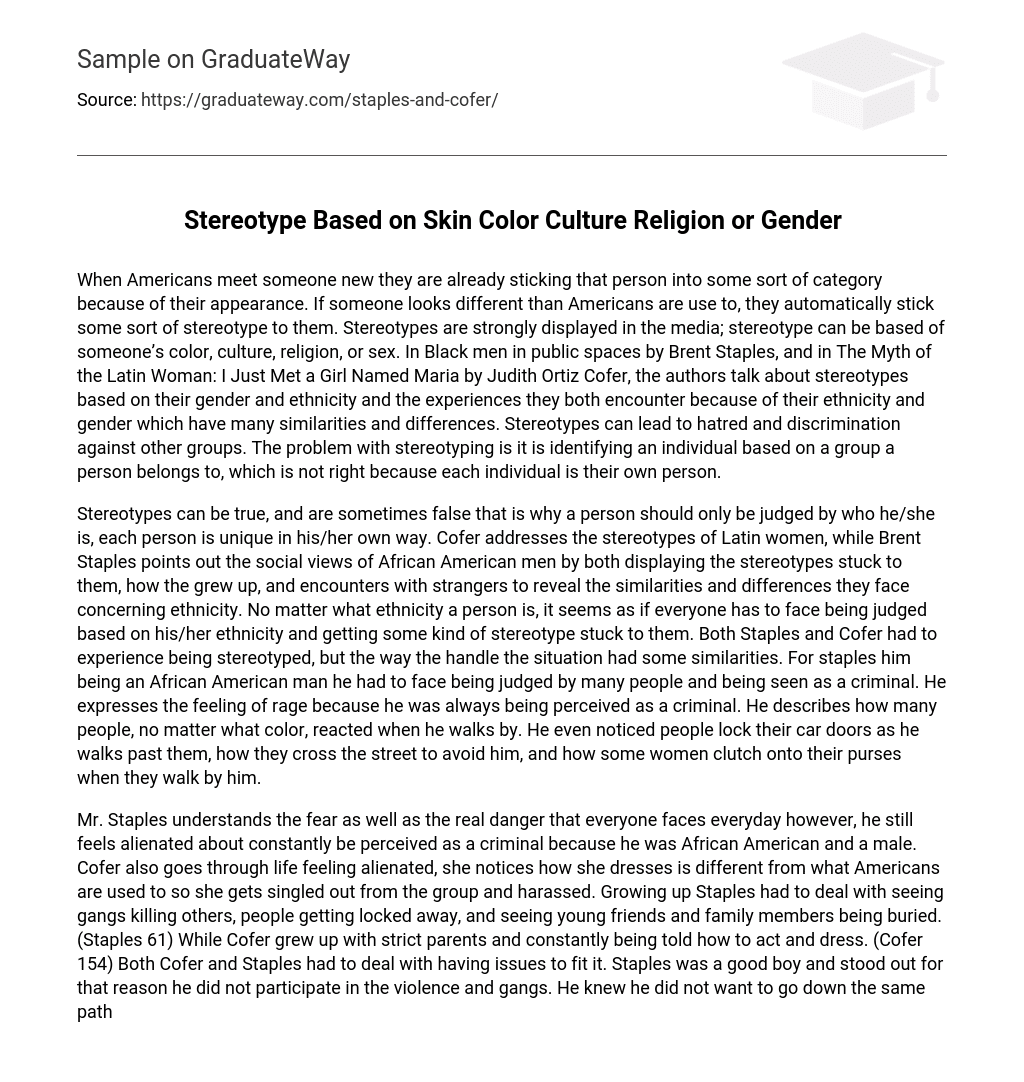The text examines the tendency of Americans to categorize individuals based on their appearance and attach stereotypes. These stereotypes, which may pertain to race, culture, religion, or gender, are especially prevalent in the media. Brent Staples’ “Black Men in Public Spaces” and Judith Ortiz Cofer’s “The Myth of the Latin Woman: I Just Met a Girl Named Maria” both address the stereotypes they encounter due to their ethnicity and gender. Despite differences between them, these experiences illustrate how stereotypes can breed animosity and discrimination towards specific groups. It is crucial to acknowledge that stereotyping involves labeling people based on their association with a particular group, an unfair practice considering each person’s uniqueness.
Stereotypes can be true or false, but it is important to judge a person based on their individuality. Each person is unique in their own way. Cofer and Staples discuss the stereotypes associated with Latin women and African American men, respectively. They both explore how these stereotypes are assigned to them, their upbringing, and their encounters with strangers. Regardless of ethnicity, it appears that everyone faces judgments and stereotypes. Staples and Cofer have both experienced being stereotyped, but they approach the situation in similar ways.
Staples, an African American man, has endured being judged and seen as a criminal. He expresses his anger towards always being perceived this way. When he walks by, people of any race are observed locking their car doors and crossing the street to avoid him. Additionally, some women even clutch onto their purses when he passes by.
Both Mr. Staples and Cofer experienced a sense of alienation in their lives. Mr. Staples, an African American male, constantly felt that he was perceived as a criminal. He understood the fear and danger that everyone faced on a daily basis. Furthermore, his upbringing exposed him to the harsh realities of seeing gangs killing others, people being locked away, and having to attend the funerals of young friends and family members. On the other hand, Cofer also experienced a similar feeling of being isolated. She noticed that her style of dressing was different from what Americans were accustomed to, which made her stand out and face harassment from the group. Additionally, Cofer grew up with strict parents who dictated how she should act and dress. Despite these challenges, both individuals strived to fit in: Staples stood out as a good boy who refused to engage in violence and gang activities, whereas Cofer struggled with not belonging due to her different ethnicity and unconventional attire.
Both Staples and Cofer experienced judgment due to their differences while growing up. Staples faced disapproval for not participating in violence and gaining power, which was considered abnormal in his community. On the other hand, Cofer was seen as peculiar by Americans for dressing like people from her home country. While both essays discuss stereotypes within specific groups, the encounters Staples and Cofer had with people were quite distinct. In Cofer’s essay, average Latin women are often stereotyped as sex symbols. These women are not seen as intimidating but rather as sexy or domestic, and they are commonly approached with sexual advances or mistaken for housekeepers, maids, or waitresses. Conversely, Staples not only faced judgement based on his intimidating appearance but also instilled fear in those who encountered him. Unlike Cofer, who faced harassment from people approaching her, Staples was seen as a threat and was unapproachable due to his imposing stature.
Staples recounts instances where he observed people’s reactions to him at night. He noticed car doors being locked when he crossed streets and encountered pedestrians who became tense around him. Although Staples was not a criminal, he was perceived as one due to his intimidating appearance. Similarly, Cofer, a Latina, faced discrimination and harassment, often being mistaken for a waitress. Both individuals have experienced numerous examples of being judged based on their race or appearance.
When working as a journalist in Chicago, Staples experienced a situation where he was mistaken for a burglar or criminal by the office manager, while Cofer went through a similar incident where she was mistaken for a waitress by older women during her first poetry reading. Both Staples and Cofer had valid reasons to feel upset in these situations, but instead of getting angry, they chose to take action to correct these misconceptions. While Staples believed he was at fault in these situations and accepted that people would always judge him because he is an African American male, Cofer saw herself as the victim and wanted those who had misconceptions to change their ways. Cofer also hoped that these individuals would understand why it’s important to be more knowledgeable about different cultures.
Both authors, Cofer and Staples, belong to different genders, which leads to the application of different stereotypes towards them in distinct ways. Despite their different ethnicities and genders, both Cofer and Staples faced similar challenges related to their ethnicity, albeit in different situations. What set Cofer and Staples apart from other individuals who experience stereotyping is that they did not assume the role of a victim; instead, they acknowledged that these stereotypes were incorrect and aimed to prove so. The purpose behind their respective essays was clear: Staples sought to shed light on how society’s perception of Black males impacts them, while Cofer aimed to challenge misconceptions surrounding Latin women’s stereotypes. While some people may agree with Staples and Cofer’s objectives and view stereotypes as incorrect, others may still believe in them. Stereotypes are a persistent issue that will not be eradicated anytime soon; therefore, it is crucial that individuals refrain from contributing to them.





